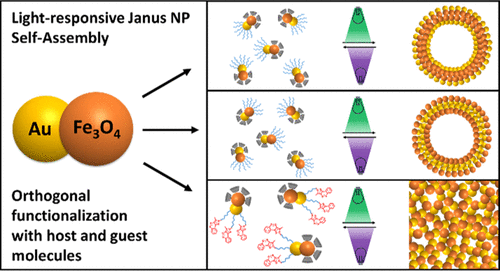Our official English website, www.x-mol.net, welcomes your
feedback! (Note: you will need to create a separate account there.)
Photo-Responsive Self-Assembly of Plasmonic Magnetic Janus Nanoparticles
Langmuir ( IF 3.7 ) Pub Date : 2021-09-09 , DOI: 10.1021/acs.langmuir.1c01979 Maximilian Niehues 1, 2 , Sabrina Engel 1, 2 , Bart Jan Ravoo 1, 2
Langmuir ( IF 3.7 ) Pub Date : 2021-09-09 , DOI: 10.1021/acs.langmuir.1c01979 Maximilian Niehues 1, 2 , Sabrina Engel 1, 2 , Bart Jan Ravoo 1, 2
Affiliation

|
Stimuli-responsive self-assembly of nanoparticles is a versatile approach for the bottom-up fabrication of adaptive and functional nanomaterials. For this purpose, anisotropic building blocks are of particular importance due to the unique shapes and structures that can be obtained upon self-assembly. Here, we demonstrate the photo-responsive self-assembly of plasmonic magnetic “dumbbell” Janus nanoparticles (Au–Fe3O4) via the host–guest interaction of the supramolecular host cyclodextrin and the molecular photoswitch arylazopyrazole. We developed efficient ligand exchange procedures that enable the introduction of functional ligands, respectively, to the surface of the gold or magnetite core of the dumbbell. Our results indicate that distinct nanoparticle superstructures arise in aqueous solutions if nanoparticle aggregation is crosslinker-induced or self-induced and that the reversible formation and fragmentation of the superstructures can be modulated with light.
中文翻译:

等离子磁性 Janus 纳米粒子的光响应自组装
纳米粒子的刺激响应自组装是一种自下而上制造自适应和功能性纳米材料的通用方法。为此,各向异性积木具有特别重要的意义,因为它们可以通过自组装获得独特的形状和结构。在这里,我们展示了等离子体磁性“哑铃”Janus 纳米粒子(Au-Fe 3 O 4)的光响应自组装通过超分子宿主环糊精和分子光开关芳基唑吡唑的主客体相互作用。我们开发了有效的配体交换程序,能够分别将功能性配体引入哑铃的金或磁铁矿核心的表面。我们的结果表明,如果纳米颗粒聚集是交联剂诱导或自诱导的,则在水溶液中会出现不同的纳米颗粒超结构,并且超结构的可逆形成和破碎可以用光进行调制。
更新日期:2021-09-21
中文翻译:

等离子磁性 Janus 纳米粒子的光响应自组装
纳米粒子的刺激响应自组装是一种自下而上制造自适应和功能性纳米材料的通用方法。为此,各向异性积木具有特别重要的意义,因为它们可以通过自组装获得独特的形状和结构。在这里,我们展示了等离子体磁性“哑铃”Janus 纳米粒子(Au-Fe 3 O 4)的光响应自组装通过超分子宿主环糊精和分子光开关芳基唑吡唑的主客体相互作用。我们开发了有效的配体交换程序,能够分别将功能性配体引入哑铃的金或磁铁矿核心的表面。我们的结果表明,如果纳米颗粒聚集是交联剂诱导或自诱导的,则在水溶液中会出现不同的纳米颗粒超结构,并且超结构的可逆形成和破碎可以用光进行调制。











































 京公网安备 11010802027423号
京公网安备 11010802027423号